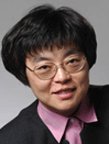C. J. Chang-Hasnain: Difference between revisions
No edit summary |
No edit summary |
||
| (5 intermediate revisions by 3 users not shown) | |||
| Line 1: | Line 1: | ||
== | {{Biography | ||
|Image=Chang Hasnain.jpg | |||
|Associated organizations=University of California | |||
|Fields of study=Lasers | |||
}} | |||
C.J. Chang-Hasnain’s groundbreaking contributions to the physics and design of vertical cavity surface emitting lasers (VCSELs) have been instrumental in establishing VCSELs as the dominant technology for multimode fiber applications. Used in applications ranging from Ethernet data networks to computer mice to laser printers, VCSELs can be turned on and off very fast and manufactured at very low cost in wafer-scale. Dr. Chang-Hasnain explained the modal structure of VCSELs and demonstrated the first planar structure, which was commercialized. She was first to demonstrate multi-wavelength VCSEL array for multimode-fiber interconnects and 140-wavelength array with precise wavelength variation. She developed the first tunable VCSEL structure with a wide tuning range and later invented a high-contrast grating, which led to a tunable laser with a 160x speed improvement. | |||
[[ | An [[IEEE Fellow Grade History|IEEE Fellow]], Dr. Chang-Hasnain is currently the John R. Whinnery Chair Professor of Electrical Engineering and Computer Science at the University of California, Berkeley. | ||
[[Category:Lasers]] | |||
{{DEFAULTSORT:Chang-Hasnain}} | |||
Latest revision as of 19:48, 19 January 2016
- Associated organizations
- University of California
- Fields of study
- Lasers
Biography
C.J. Chang-Hasnain’s groundbreaking contributions to the physics and design of vertical cavity surface emitting lasers (VCSELs) have been instrumental in establishing VCSELs as the dominant technology for multimode fiber applications. Used in applications ranging from Ethernet data networks to computer mice to laser printers, VCSELs can be turned on and off very fast and manufactured at very low cost in wafer-scale. Dr. Chang-Hasnain explained the modal structure of VCSELs and demonstrated the first planar structure, which was commercialized. She was first to demonstrate multi-wavelength VCSEL array for multimode-fiber interconnects and 140-wavelength array with precise wavelength variation. She developed the first tunable VCSEL structure with a wide tuning range and later invented a high-contrast grating, which led to a tunable laser with a 160x speed improvement.
An IEEE Fellow, Dr. Chang-Hasnain is currently the John R. Whinnery Chair Professor of Electrical Engineering and Computer Science at the University of California, Berkeley.
